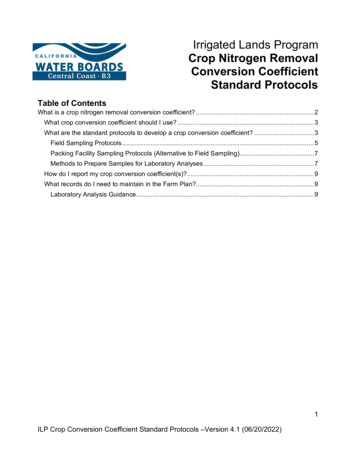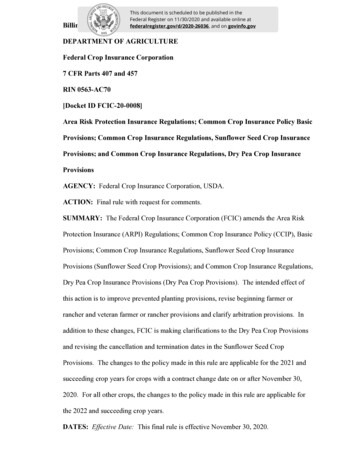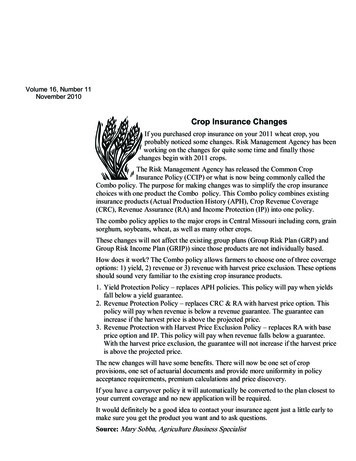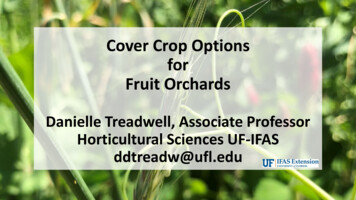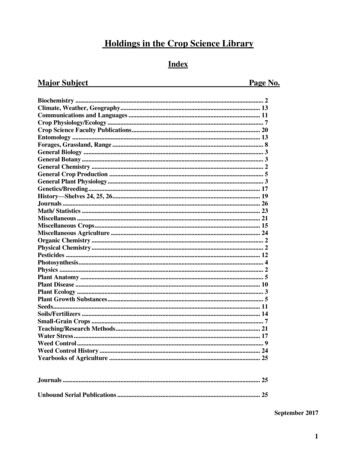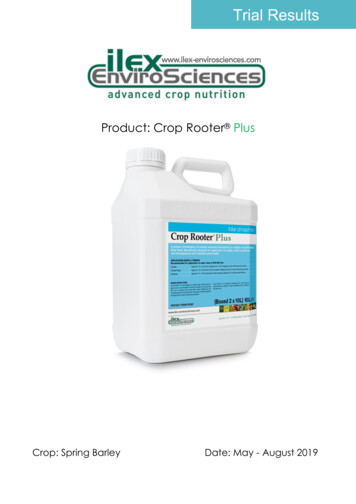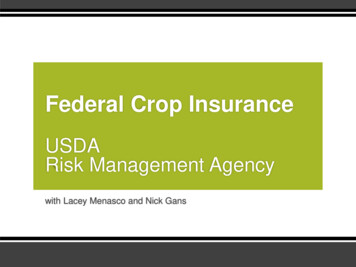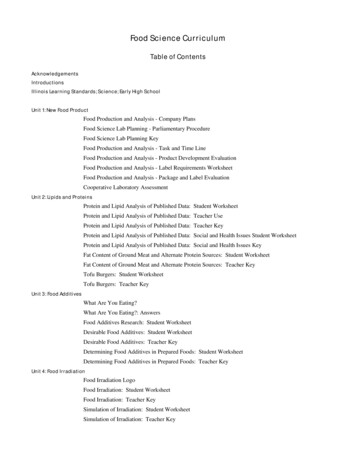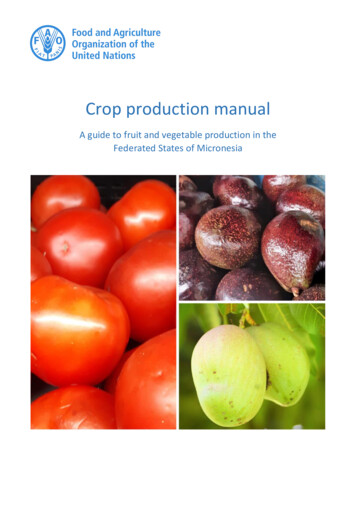
Transcription
Crop production manualA guide to fruit and vegetable production in theFederated States of Micronesiaii
iii
Crop production manualA guide to fruit and vegetable production in theFederated States of MicronesiaCompiled by:Sayed Mohammad Naim KhalidThis manual was produced under TCP/MIC/3601, “Strengthening the capacity of FarmersAssociations to increase production and marketing of root crops, fruits and vegetables in FSM”project.FAO Subregional Office for the PacificFood and Agriculture Organization of the United NationsApia, 2020iv
Required citation:FAO. 2020. Crop production manual. Appia.The designations employed and the presentation of material in this information product do not imply theexpression of any opinion whatsoever on the part of the Food and Agriculture Organization of the UnitedNations (FAO) concerning the legal or development status of any country, territory, city or area or of itsauthorities, or concerning the delimitation of its frontiers or boundaries. The mention of specific companiesor products of manufacturers, whether or not these have been patented, does not imply that these havebeen endorsed or recommended by FAO in preference to others of a similar nature that are not mentioned.The views expressed in this information product are those of the author(s) and do not necessarily reflectthe views or policies of FAO.ISBN 978-92-5-132128-7 FAO, 2020Some rights reserved. This work is made available under the Creative Commons AttributionNonCommercial-ShareAlike3.0 IGOlicence(CC BY-NC-SA 3.0 3.0/igo/legalcode).Under the terms of this licence, this work may be copied, redistributed and adapted for non-commercialpurposes, provided that the work is appropriately cited. In any use of this work, there should be nosuggestion that FAO endorses any specific organization, products or services. The use of the FAO logois not permitted. If the work is adapted, then it must be licensed under the same or equivalent CreativeCommons licence. If a translation of this work is created, it must include the following disclaimer alongwith the required citation: “This translation was not created by the Food and Agriculture Organization ofthe United Nations (FAO). FAO is not responsible for the content or accuracy of this translation. Theoriginal [Language] edition shall be the authoritative edition.”Disputes arising under the licence that cannot be settled amicably will be resolved by mediation andarbitration as described in Article 8 of the licence except as otherwise provided herein. The applicablemediation rules will be the mediation rules of the World Intellectual Property ules and any arbitration will be conducted in accordance with theArbitration Rules of the United Nations Commission on International Trade Law (UNCITRAL).Third-party materials. Users wishing to reuse material from this work that is attributed to a third party,such as tables, figures or images, are responsible for determining whether permission is needed for thatreuse and for obtaining permission from the copyright holder. The risk of claims resulting from infringementof any third-party-owned component in the work rests solely with the user.Sales, rights and licensing. FAO information products are available on the FAO website(www.fao.org/publications) and can be purchased through publications-sales@fao.org. Requests forcommercial use should be submitted via: www.fao.org/contact-us/licence-request. Queries regardingrights and licensing should be submitted to: copyright@fao.org.Cover photographs: FAO/ K. Hadfieldv
ContentsPreface . viiiAcknowledgements.ixFarming basics . 1Introduction . 3Why start your own farm? . 3Picking a good spot for your garden . 3Choosing what crops to plant . 4Finding seeds/seedlings . 5Planning your farm . 5Layout. 5Raised beds . 5Traditional rows . 6Square foot gardening . 6Mulching . 6When to plant . 6Improving the soil . 7Testing the soil . 7Clearing weeds . 7Compost . 8Manure. 8Planting the crops . 8Succession planting . 9iv
Crop rotation . 9Maintaining the garden . 10Watering . 10Weed control . 11Pest control . 11Fertilizer . 11Harvesting the crops . 12Organic pest control . 14Root crops production. 15Sweet potato (Ipomoea batatas) . 17Swamp taro (Cyrtosperma merkusii) . 18Cassava (Manihot esculenta) . 19Taro (Colocasia esculenta) . 20Arrowleaf elephant (Xanthosoma. 21saggitifolium) . 21Ginger (Zingiber officinale) . 22Turmeric (Curcuma longa) . 23Yam (Dioscorea alata) . 24Vegetable production. 25Capsicum (Capsicum grossum) . 27Chillies (Capsicum annuum) . 29Chinese cabbage (Brassica chinensis) . 30Corriander (Coriandrum sativum) . 31Cucumber (Cucumis sativus) . 32Eggplant (Solanum melongena) . 33v
French bean (Phaseolus vulgaris) . 34Lettuce (Lactusa sativa) . 35Long bean (Vigna sesquipedalis) . 36Okra (Abelmoschus esculentus) . 37Pumpkin (Cucurbita maxima) . 38Radish (Raphanus sativus) . 39Spring onion (Allium cepa) . 40Zucchini (Cucurbita pepo) . 42Fruit production. 43Acid lime (Citrus aurantifolia) . 45Sweet orange (Citrus sinensis) . 46Mandarin orange (Citrus reticulate) . 47Sapota (Manilkhara achras) . 48Avocado (Persia americana) . 49Passionfruit (Passiflora edulis) . 50Pineapple (Ananas comosus) . 51Watermelon (Citullus lanatus) . 52Banana (Musa sapientum) . 53Coconut (Cocos nucifera) . 55Kura (Noni) (Morinda citrifolia). 56Mango (Mangifera indica) . 57Papaya (Carica papaya) . 58Soursop (Annona muricata) . 59Vanilla (Vanilla fragrans) . 60Tamarind (Tamarindus indica L) . 61vi
Dragon fruit (Hylocereus undatus) . 62Star apple (C. cainito L.) . 63Mangosteen (Garcinia mangostana) . 64Lanzones (Lansium domesticum C) . 65Rambutan (Nephelium lappaceum Linn.). 66Barbados cherry (Malpighia punicifolia L.) . 67Annex 1: A guide to backyard composting . 69Annex 2: Natural and homemade pesticides . 71Annex 3: Synthetic fertilizers . 75References and further reading . 80vii
PrefaceThis manual is intended to be a guide to the agriculture extension personnel,horticultural producers as well as agricultural institutions in their endeavor toimprove productivity in the horticultural sub-sector. This manual will raiseawareness and provide decision support information about opportunities atfarm and how to do basic farming for subsistence and market and ultimatelyincrease the income of farmers and improve their livelihoods.Pohnpei and Yap States currently produce limited amount of food locally andexport is also limited. The imports of substantial quantities of vegetables,fruits and root crops is amounting to millions of dollars annually. This is partlyowing to the fact that the necessary information on crop production locally isnot readily available to assist producers in their production.This manual is designed to provide guidelines on seedling production andmanagement, plant spacing, cropping program, soil fertility and cropprotection. It is hoped that this manual will contribute modestly to the goalof improving vegetable production in the country.viii
AcknowledgementsThe following individual contributed to conceptualization, writing, reviewing,editing, and improving technical accuracy of this manual. Their valuablecontributions are hereby gratefully acknowledged: Mr. Adelino Lorens - Chief of Agriculture Pohnpei, FSMMs. Marlyter Silbanuz – National Project Coordinator, FSMMr. Tamdad Sulag – Chief of Agriculture Yap, FSMDr. Nacanieli (Nat) Tuivavalagi – Agronomy Researcher, College ofMicronesia, FSMMr. Konrad Englberger – Volunteer Plant Protection Expert, FSMMr. Jackson Phillip – Program Coordinator, College of MicronesiaFSMMr. Sawdey, Sharon – Resource Conservationist, NRCS/USDA - FSMDr. Leon Numaco – Horticulture Consultant, FAOMr. Gumercindo Tumbali – Farm Management & MarketingConsultant, FAOMr. Kadalino Lorens – Agriculturist, Division of Agriculture,Department of R&D Pohnpei State, FSMMr. Santos, Gibson – Soil Conservation Technician, NRCS/USDA, FSMMr. Nicholson Solomon – Director, Department of Resources &Development, Pohnpei, FSMix
Farming basics1
2
Farming basicsIntroductionWith so much emphasis today oneating natural, organic foods – not tomention the rising costs associatedwith buying them, many people areconsidering growing their ownvegetables in a home garden. It’s veryeasy to grow your own vegetables,and at harvest time, vegetablegardening is a very rewardingpastime.All your garden really needs issunshine (6–8 hours of sun each day,in the summer), some soil, fertilizer,and a little attention to watering,weeding and pest management.As a gardening beginner, your firstvegetable garden will require thelargest amount of work, but don’t letthat dissuade you – the work you putin up front won’t have to be repeatednext year, and the rewards speak forthemselves.As you can see, thereare many great reasons to start yourown farm. Apart from allowing you togrow your own food, conservingenergy and saving money, own farmwill also help to control runoff fromrainfall and guard against flooding.A farm can act as a sound buffer,lowering noise levels in yourneighborhood. Your farm will attracta variety of local and migratorywildlife like birds and butterflies, notto mention helping to conserveimportant creatures like bees – whoare vital to our ecosystem – andhelping to reduce CO2 in ouratmosphere, replacing it with oxygen.Additionally, a farm is a great spacefor both children and adults toexperience the outdoors, and get offthe sofa. A garden can create groundshade, helping with cooling, and canwork as a filter for dust andpollutants.Why start your own farm?Across the world, many people arehaving little farms. In FSM mostpeople have access to land and theclimate is suitable for cropproduction. And for the cost of seeds,tools, and water, they’re enjoyingfood that’s as fresh and local as it canpossibly be, all while spending lesstime shopping for groceries and moretime at home, connecting with theirfamily and friends.Picking a good spot for your gardenNow that you’ve decided to start yourfarm, the first step is to find theperfect location. There are severalthings you should keep in mind:Start Small. As we mentioned, yourfirst farm is typically the most work toset up, so starting small is a goodidea. Set up a manageable area foryour garden bed(s), whether they arein the ground, raised beds, or incontainers, and know what you’re3
going to plant (and the spacerequirements of those plants) aheadof time.open plain. Find natural windbreakersin the surrounding area or considerbuilding a fence to protect your plantsfrom the wind to minimizedamage from wind exposure.Sunlight. Sunlight is the mostimportant thing for any farm.Vegetables require at least six hoursof sun each day – and if you can get 8hours, that’s better. Don’t worry toomuch about afternoon or morningsun, as long as the garden gets atleast six hours total, you’re golden.Good Soil. As farmers, we know thatgood soil means good plants! Whenlooking at the soil in your ownground, darker tends to be better, butjust about any soil is workable – aslong as it’s not full of rocks, roots, orother obstructions. Even mediocresoil can be improved with minerals,manure, and sand to make itexcellent. And, if all else fails, a raisedbed with formulated soil is always anoption.Choosing what crops to plantNow that you have a location, it’stime to decide what to plant. You’llwant to maximize your space andgrow plants suited to your local area,as well as considering the time vs.reward – corn, for example, isdelicious, but takes up lots of spaceand takes months to get a singleharvest, while pole beans are quirespace-efficient and produce beans forweeks.Easy to grow. For the beginning,having vegetables that are basicallyFigure 1: seedling production in traysfoolproof is a great plan. Plants likeChinese cabbage, tomatoes, gourdslike squash and eggplant, greens suchas lettuce or Swiss chard, and rootvegetables like taro tend to be verysimple.Water source. Apart from sun andsoil, water is the third piece of thepuzzle to make a healthy garden.Choose a location close to a watersource – like river, rain watercollection, a hose, well, or otherhydrant where you can easily makesure the garden stays watered – andwhile we’re at it, plants don’t grow intotally soaked soil, so avoid areas thattend to collect rainwater. Higherground is best!Suitable for your region. Whenplanning your farm, pay a visit to yourfarmer’s market and find out what’salready grown locally. This will helpyou to ensure you aren’t fighting anuphill battle in getting a plant thatisn’t exactly suited to your area tothrive – plus, by growing what otherfarmers are growing, you can alwaysgo to those folks for help if needed.Wind shelter. This one is especiallyimportant on a rooftop, or out in an4
neglect, wind, waterlogging, or pests.To prevent your farm experience frombeing a disaster, take some time toplan the farm.Companion planting. Companionplanting can help ensure that all yourplants thrive by assisting with pestcontrol. By planting companions nextto each other, the idea is that wewant all the natural pests attracted tothe first plant to be repelled by thesecond, and vice-versa.For example, onion pairs well withtomatoes and leafy greens likelettuce, but if planted next to beansor peas you may run into pesttroubles.LayoutNo matter what kind of layout youend up using for your farm, the firstthing to think about is location.Choose a basically level area in higherground if possible, for good drainage.Take in mind that sun is a concern(6–8 hours) as well as protection fromwind.Finding seeds/seedlingsBuying/receiving seeds can be prettyoverwhelming for farmers because ofthe sheer volume of differentcompanies and varieties out there.The best advice is, “Read the label”or, “Ask your extension officer”.This will let you know how difficultthe plant is to grow, when to plant,and what’s required.Raised beds FAO/ S.M. Naim Khalid FAO/ S.M. Naim KhalidFigure 2: An example of raised bedproductionRaised bed gardening has becomeone of the most popular way ofgrowing vegetables today. The waythey allow you to control space, soil,water levels, and location make themideal for many gardeners.If you go with a raised bed layout,construct beds that are no more than3–4 feet wide, with space for walkingpaths in between. This will ensureFigure 1: Seeding production intraysPlanning your farmFarmers usually make mistake here.First time farms can easily get out ofhand, or unwieldy, or fall victim to5
that you’re able to properly attend to– and harvest – every plant.on your plant roots from heat, and incooler months.On the other hand, it does createcool, dark spaces that are the favoredenvironments of Giant African snails,slugs, earwigs, and other undesirables– so only use a thin layer. Mulchshould not touch the stem of plants.Traditional rowsFor those who have the space,traditional row gardening can be agreat option. Planting vegetables inlong rows allows you to increase thespace between plants, improving airflow around them and giving themmore space to grow.When to plantWhen considering the question ofwhen to plant, you’ll have to go backto the question of what to plant.Remember, reading all those labelson your seed packets will ensure thatyou’re planting things at the righttimes.Choose seeds that make goodHere’s a rule of thumb for rowgardening – try to plant the tallerplants toward the west, and shortertoward the east. That way yourshorter plants don’t spend those vitalsunshine hours in the shade of thetaller ones. FAO/ S M. Naim KhalidSquare foot gardeningFor beginner farmers, square footgardens often tend to be a great wayto begin. Larger gardens are prone toweeds and can be overwhelming forthe novice. Square foot gardening issimilar to raised bed gardening, but itis further subdivided into individualsquare-foot plots.MulchingFor farmers, the purpose of mulch isfairly straightforward: mulch is like abarrier keeping sunlight and ambientair out of the soil. Mulching allowssoil to stay cooler, meaning less stressFigure 3: Production in furrowsand rowscompanions, and thrive at similarintervals for the best beginnergardening experience.6
FAO/ S M. Naim KhalidTesting the soilNow, brace yourself, because we’regoing to talk a little chemistry. Don’tpanic, you don’t need to be ascientist. So, as you may rememberfrom chemistry or biology class, pH isa measure of the acidity of asubstance – remember, 7 is neutral,and a pH lower than 7 is acidic, whilea pH above 7 is basic.Soil is no exception, and it has a pHvalue, and unsurprisingly, plants tendto like neutral soil. For moreinformation and help please contactthe extension agents and localagriculture department.Figure 4: An example of mulch withstrawClearing weedsThe amount of time you’ll spendworrying about weeds, in a sense,depends on which style garden youuse. While square-foot gardens andraised beds using controlled soils canremain fairly weed-free, a traditionalrow garden can inherit weeds fromplant life that inhabited the soilbefore it was tilled.A good way to prevent weeds fromstarting is to smother them. Afterclearing the ground for your garden,just leave the clippings of the grassand weeds that were therepreviously, and cover the area withnewspaper.Keep the newspaper damp bywatering it each day, and walk over itto keep everything pressed down.This will discourage the morestubborn weeds from re-growing.If 4you want to think ahead, considergrowing something that thrives inheat and can be harvested early – likeChinese cabbage, and then replacingthem as the weather cools with acool-weather plant like broccoli. Ofcourse, if you’d rather simply do oneplanting and one harvest, especiallyas a beginner, that’s just fine too.Improving the soilMost soils are entirely capable ofgrowing a vegetable garden – andeven mediocre soil can be improved.For a really successful garden, somesoil improvements is a must. Let’stake a look at some of the ways youcan improve your soil.7
As the plant matter from yourclippings begins to decay, earthwormswill be attracted, and they will aeratethe soil and add nutrients – a bonus!seeds at the ready, it’s time to get tothe good stuff: planting your garden.Planting time is the second mostexciting time to be a gardener (thefirst is, of course, harvest time) – thisis when you can finally put all thehard (but worthwhile) work ofbuilding your first garden behind you,and really begin the enjoyableprocess of growing your own food.Plants can be cultivated by directseeding or transplanting.CompostCompost is a great way to createextremely nutrient-rich soil, and itcouldn’t be easier to make. Justcreate some layers of organic material– dry leaves, kitchen veggie scraps,shredded paper, plant clippings, andjust a little bit of soil.Over time, this will turn intosomething called humus, and it’sexcellent for building soil. Furtherdetails on how to make compost ispresented in Annex 1.How to plant the seedsThe first step to actually utilizing yourgarden to grow delicious vegetables isto plant your seeds. If you ask tengardeners how they plant their seeds,you’ll likely get ten different answers,as everyone develops their ownroutine. But, as a general guide,here’s our preferred method ofstarting seeds for beginners. Seedscan be directly planted in soil orgrown in nursery and thentransplanted to prepared beds.Begin by marking out rows withstakes on either side of the garden,and stretching string between them.Alternatively, you can use a long,straight piece of wood as a guide.Whichever method you use, use a hoeor trowel along your guide to cut afurrow into the soil. It should look likea V-shaped indentation a few inchesdeep – refer to your seed packets formore specific depth requirements.Now that you have your row defined,you can distribute the seeds along therow, taking care to distribute themManureIn addition to composting, plenty offertilizers and other synthetic soilenrichment methods are around tohelp improve soil. However, for manygardeners, nothing is better than thetried-and-true method of manure.In comparison, manure contains alittle less nutrient content than thesparkly synthetic fertilizers, butnothing is better at providing carbonand carbon compounds. This isorganic material that helps build andfortify the structure of soil, and that’ssomething no fertilizer can do.Planting the cropsNow that you have your garden laidout, your soil prepared, and your8
more or less evenly in small groups,or individually for larger seeds. Don’tbe afraid to use additional seeds. Thiswill help cut down on loss shouldsome of your seeds fail to germinate.Finally, once your row has beenpopulated with seeds, use yourtrowel or hoe to pull fine soil over theseeds – take care to avoid large clodsof soil and rocks. Finally, give the soilsome taps with your tool of choice tofirm it and ensure that moisture inthe soil has good contact with theseeds, and to help the soil to retainmoisture.Once you’ve planted and coveredyour seeds, use a gentle shower fromyour garden hose to water them – begentle here, you don’t want to disturbthe seeds or the soil. Keep up thepractice of making sure these seedsare watered to ensure healthygermination until you see sprouts.Once the seeds have sprouted, lookfor them to develop into seedlings.They will start to sprout leaves, and inthe case of multiple plants, wait forone of the plants to develop threewell defined sets of leaves.Once the third set has developed,then do a little thinning – you’ll wantto thin out the smaller, weaker plantsso that only the stronger ones areleft. This ensures that the smallerplants aren’t stealing moisture andnutrients from the champions of thebatch.It’s best, and easiest, to thin whilethese seedling are small, so thatpulling them up doesn’t disturb theroots of the stronger plants.Succession plantingAs a gardener, you may wish to simplygarden for a single season: plant,tend, harvest, and then leave thegarden beds be until next summer.That’s totally fine, but if you’d like agarden that really works for you yearround, consider succession planting.Succession planting isn’t difficult, andit will truly maximize the rewards youget from your home vegetablegarden. By using succession planting,you could double or triple the volumeof fresh vegetables you harvest fromyour garden.By continuously planting andharvesting each season in spring,Summer, and Fall, with weatherappropriate plants, you can turn yourgarden into a very efficient foodsource.Crop rotationThose of us who have been gardeningfor years all have a story about abumper crop one year leading to aminuscule harvest the next.Bountiful plants followed by punierversions is a very common tale amonggardeners, and the culprit isn’t thevalidity of your (or our) green thumb– the answer to fighting this boomand-slump cycle is crop rotation.Crop rotation is, essentially, anextension of the work you did ininitially laying out your garden, anddeciding where to plant what.9
Moving the plant groups that youhave placed together to new locations– and new soil – every year issomething that some gardeners don’tdo, but it can be a huge improvementto nearly any garden, in several ways.First of all, rotating crops year afteryear helps to keep that soil that wespent so much time worrying abouthealthy and fertile. By planting thesame plants in the same soil eachyear, those same plants are going todrain the same nutrients – in thesame way – year after year, and overtime that soil will become lesseffective.Additionally, rotating your plantgroups helps to mitigate soil diseasesand pests mainly nematodes.What are those? These are conditionslike verticillium wilt and rootwormsthat prefer certain types of plants – soplanting th
Crop production manual A guide to fruit and vegetable production in the Federated States of Micronesia Compiled by: Sayed Mohammad Naim Khalid This manual was produced under TP/MI/3601, " Strengthening the capacity of Farmers Associations to increase production and marketing of root crops, fruits and vegetables in FSM" project.
